The Crucial MX300 750GB SSD Review: Micron's 3D NAND Arrives
by Billy Tallis on June 14, 2016 9:00 AM ESTAnandTech Storage Bench - The Destroyer
The Destroyer is an extremely long test replicating the access patterns of very IO-intensive desktop usage. A detailed breakdown can be found in this article. Like real-world usage and unlike our Iometer tests, the drives do get the occasional break that allows for some background garbage collection and flushing caches, but those idle times are limited to 25ms so that it doesn't take all week to run the test.
We quantify performance on this test by reporting the drive's average data throughput, a few data points about its latency, and the total energy used by the drive over the course of the test.
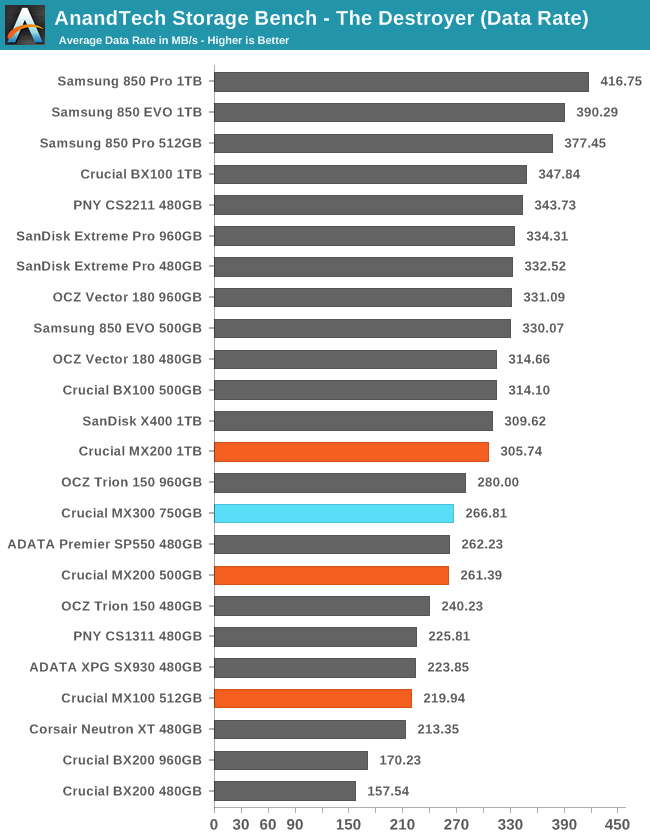
The average data rate for the MX300 is between the scores of the 1TB and 500GB MX200 but a little closer to the latter. This is acceptable performance but not really an upgrade over the MX200.
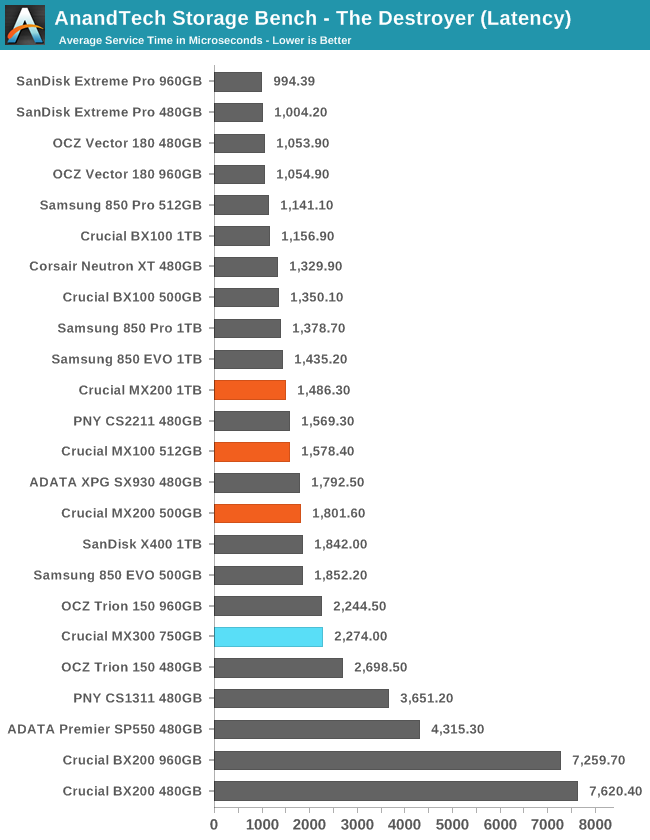
The average service time of the MX300 is slow enough to put it among the budget planar TLC drives and well behind the SanDisk X400.
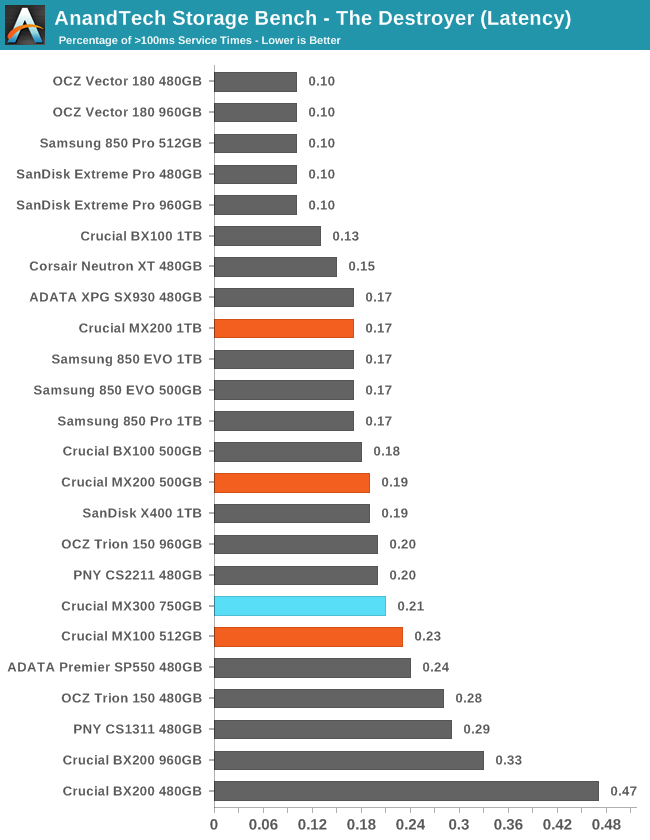
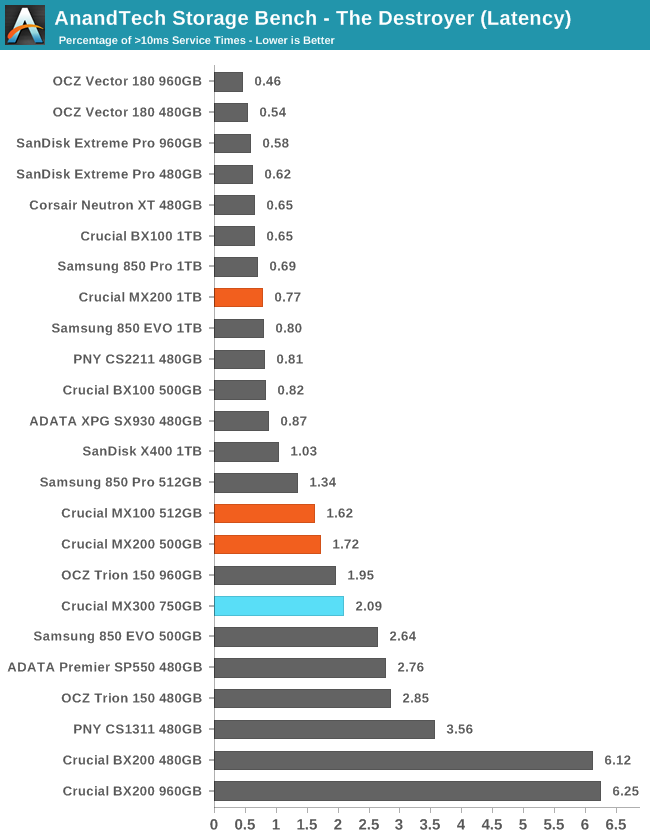
The MX300 has a higher frequency of both moderate and severe latency outliers than the MX200, but it isn't a huge discrepancy. The performance relative to the SanDisk X400 shows that there is room for improvement.
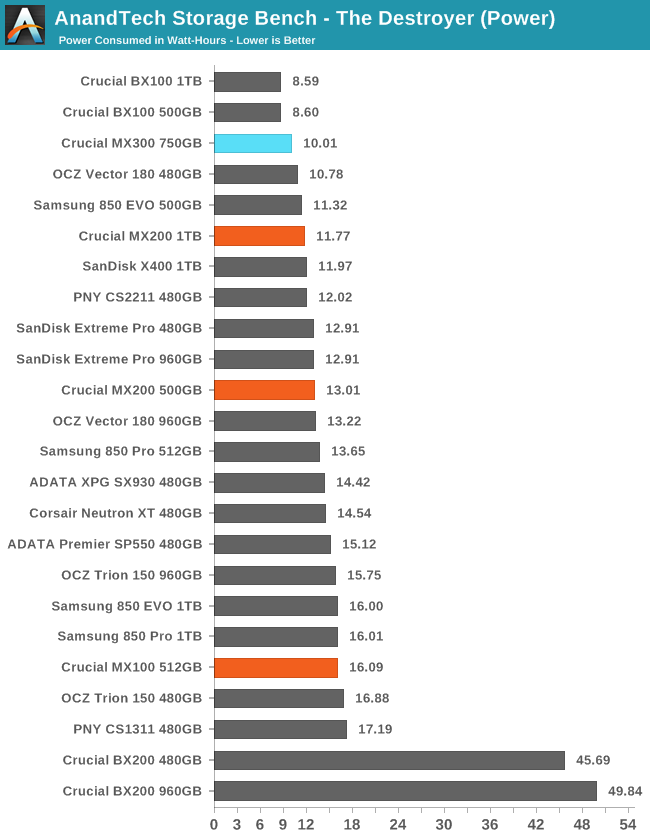
The MX300's power consumption comes in a distant second place behind the BX100, but this is still remarkable efficiency for a TLC drive.










85 Comments
View All Comments
Lonyo - Wednesday, June 15, 2016 - link
Um, the conclusion is entirely negative. Read the conclusion? It's slow, but not as slow as planar TLC drives. It's inexpensive, but not super cheap. It's a generation "above" in naming of the MX200, but is slower. It has to compete on price because it can't compete on performance. It has an acute weakness in random reads.The main strengths are that it's fairly power efficient.
rtho782 - Tuesday, June 14, 2016 - link
Meh, another SSD to compete on price. They have really become commodities!cknobman - Tuesday, June 14, 2016 - link
Not cheaper.Slower.
Uses more power.
No improvement on endurance.
Am I missing anything major here?
I just dont see anything that is purchase worthy here.
azazel1024 - Tuesday, June 14, 2016 - link
If you need >512GB, but don't NEED 1TB and can't justify the price of a 1TB drive.I need to, sadly, buy a new SSD soon and I've been going back and forth between MLC and TLC. My issue is that my budget is extremely limited right now, but I also can't wait a whole lot longer.
The 240/256GB TLC drives just seem to have shite for performance once their SLC caches are filled, and their random read performances are nothing to write home about either. They also tend to have small SLC caches, which increases the likelihood of hitting the cache limit and near full drive performance is especially bad on most of them and I have about 130GB of data I need to transfer off a 120 and a 60GB SSD to it to run one SSD boot drive. 480/512GB TLC drives at around $110-120 are a bit out of my price range (yes, my budget is THAT limited), but it would keep utilized capacity fairly low.
240/256GB MLC drives on the other hand tend to have much better performance, especially as the drive fills up, except the MX200 :-(. Which means in the 240-256GB capacity range, an MX200 isn't much of an option for me. Right now I am looking at a PNY 2211 240GB drive as it seems to be a good blend of price and performance, especially performance once the drive is pretty highly utilized, and I have to face the fact that I might only have 130GB of data to move to the drive right now, but I am sure drive utilization will creep up to 150, 160, 170, 180GB given a year or two (I have a 5.4GiB RAID0 array for bulk storage of 2x3TB drives, but applications aren't getting smaller, even if I stay good on keeping only a few games loaded on the SSD at a time).
Sadly MLC 480/512GB are just well outside my price range right now.
What would be nice is seeing m.2 PCI-e based drives that aren't such a huge jump in $ per GB.
DanNeely - Tuesday, June 14, 2016 - link
While TLC drives do slow down a lot once the SLC cache is exhausted, unless you're doing video editing, batch processing of media files, etc sustained multi-gigabyte writes tend to be very uncommon in the consumer market. SLC caches are used because they're large enough to handle normal use. You really need to be pushing a lot of data at once to exhaust them.jabber - Tuesday, June 14, 2016 - link
I've tried cloning a existing build to the TLC type SSDs (I often will build a machine using a old 64GB SSD then clone it over when the new larger SSD arrives) and the write speeds can drop below 40MBps after about 2 minutes of cloning. We are talking about mainstream SSDs with USB2.0 levels of performance. Even a 5400 RPM HDD will do better.Billy Tallis - Tuesday, June 14, 2016 - link
Our sequential write test runs for three minutes at each queue depth. The slowest 3-minute average we've recorded at any queue depth was 61MB/s. For your drive cloning to be running at only 40MB/s after a mere two minutes, there has to be some other bottleneck. Your software is probably preventing the copy from proceeding at full speed, such as by alternating reading from the source drive and writing to the destination.jabber - Tuesday, June 14, 2016 - link
I said about 2 minutes. I don't actually have an exact record as I wasn't writing an article or review but let's say very soon after starting the cloning the performance dropped to a 'unacceptable' level. Anything below 200MBps write in a 2016 SSD should be classed as unacceptable. By the way it was a BX200 SSD.vladx - Tuesday, June 14, 2016 - link
Yes, most TLC drives are enough for consumer drives. In fact, I'd bet my 840 EVO still kicks this MX300's ass.Byte - Tuesday, June 14, 2016 - link
Truth be told I bet the 830 might still beat it. I put my 830 in my new 4.5GHz skylake system and it was still blazing fast. Put in a m.2 950pro and can't really even tell a difference. Now the low end stuff like Sandisk SSD Plus, you can actually tell its slower at everything.